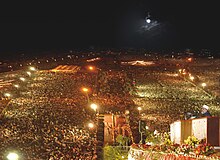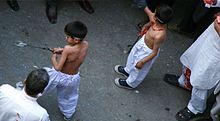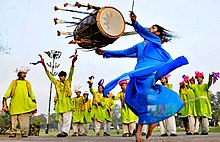Punjabi festivals (Pakistan)
| Part of a series on |
| Punjabis |
|---|
 |
 Punjab portal |
Punjabis are the majority ethnic group in Pakistan.[1] They celebrate a number of religious and cultural festivals:
List and description of Islamic festivals
[edit]Religious festivals are determined by the Islamic calendar.
| Festival | Date Observed (from year to year dates vary) | Pictures | Description |
|---|---|---|---|
| Shab-e-Barat | Sha'ban (Islamic calendar) | Shab-e-barat (lailat ul-barat or the night of deliverance) is held in the middle of Shaban (eighth month of the Islamic calendar). It is regarded as a night when the fortunes of men for the coming year are decided and when Allah may forgive sinners. Believers offer special prayers for unity, prosperity, security and restoration of peace in the country and the prosperity and unity of entire Muslim Ummah. Mosques in places such as Lahore are decorated to celebrate the occasion while arrangements for refreshments and food are also made to facilitate worshippers. Worshippers also visit graveyards to pray for the departed souls.[2] | |
| Eid ul-Adha | Zilhij (Islamic calendar) |  |
Eid-ul-Azha is celebrated to commemorate the occasion when Abraham was ready to sacrifice his son, Ismail, on God's command. Abraham was awarded by God by replacing Ismail with a goat. Muslims make pilgrimage (hajj) to Mecca during this time.[3] Muslims sacrifice animals including cow, goat, sheep and camel according to their purchasing power.[4] The children celebrate Eid ul-Adha and Eid ul-Fitr with great pump and show and receive gifts and Eidi (money) from parents and others.[5] |
| Eid-ul-Fitr | Ramadan (Islamic calendar) | Ramadan is the time of fasting that continues throughout the ninth month.[6] On this day, after a month of fasting, Muslims express their joy and happiness by offering a congregational prayer in the mosques. Special celebration meals are served.[7] | |
| Eid-e-Milad-un- Nabi | Rabi'al-Awal (Islamic calendar) |  |
Eid-e-Milad-un- Nabi is an Islamic festival in honour of the birthday of Muhammad.[8] The festival is observed in the third month of the Islamic lunar calendar called Rabi'al-Awal.[9] Various processions take place in Lahore to celebrate the festival.[10] According to Nestorovic (2016), hundreds of thousands of people gather at Minare-Pakistan, Lahore, between the intervening night of 11th and 12th Rabi' al-awwal of the Islamic calendar.[11] The festival was declared a national holiday in Pakistan in 1949.[12] |
| Muharram | Muharram (Islamic calendar) |  |
Remembrance of Muharram is a set of rituals associated with both Shia and Sunni Muslims.[13] The event marks the anniversary of the Battle of Karbala when Imam Hussein ibn Ali, the grandson of Muhammad, was killed by the forces of the second Umayyad caliph Yazid I at Karbala. Family members, accompanying Hussein ibn Ali, were killed or subjected to humiliation. The commemoration of the event during yearly mourning season, from first of Muharram to twentieth of Safar with Ashura comprising the focal date, serves to define Shia communal identity.[14] Various Tazia, Alam and Zuljinnah processions are taken out in Punjab.[15] |
List and description of festivals observed at shrines
[edit]The festivals held at shrines are determined by the Islamic calendar and the Punjabi calendar.
| Festival | Date Observed (from year to year dates vary) | Pictures | Description |
|---|---|---|---|
| Mela Chiraghan | (Varies) |  |
Mela Chiraghan is a three-day annual festival to mark the urs (death anniversary) of the Punjabi Sufi poet and saint Shah Hussain (1538-1599)[16] who lived in Lahore in the 16th century.
It takes place at the shrine of Shah Hussain in Baghbanpura, on the outskirts of Lahore, Pakistan, adjacent to the Shalimar Gardens. |
| Baha-ud-Din Zakariya | Safar (Islamic calendar) |  |
Sheikh Baha-ud-Din Zakariya known as Bahawal Haq was born at Kot Aror near Multan, towards the end of twelfth century.[17] The annual festival of Baha-ud-Din Zakariya's death is celebrated on 27th Safar, the second month of Islamic calendar.[18] |
| Data Baksh | Safar (Islamic calendar) |  |
Abul Hassan Ali Ibn Usman al-Jullabi al-Hajveri al-Ghaznawi or Abul Hassan Ali Hajvari, also known as Daata Ganj Bakhsh, which means the master who bestows treasures) was a Sufi of the 11th century. He was born around 990 CE near Ghazni, present day Afghanistan, during the Ghaznavid Empire and died in Lahore in 1072 CE. Ali Hajvari is famous for his mausoleum in Lahore, which is surrounded by a large marble courtyard, a mosque and other buildings. It is the most frequented of all the shrines in that city, and one of the most famous in Pakistan and nearby countries.[19] His Urs is on the 19th of the Islamic month of Safar.[20] |
| Sakhi Sarwar urs | Baisakh (Punjabi calendar) |  |
Syed Ahmad Sultan, popularly known as Sakhi Sarwar, was a 12th-century Sufi saint of the Punjab.[21] Various fairs are held in the Punjab. The shrine at Nigaha holds a week-long Baisakhi fair in the month of April.[22] |
| Sakhi Ghulam Qadir | 10 Chait (Punjabi calendar) | The urs are celebrated on 10 Chait. His shrine is about 5 kilometres away from Pak Pattan.[23] | |
| Baba Farid urs | Muharram (Islamic calendar) |  |
Shaikh Farid was a thirteenth-century saint. The Urs (death anniversary) of Baba Farid, takes place at the Muharram (the first month of the Muslim calendar).[24] Up to 0.9 million devotees visited the shrine during the urs in 2016.[25]
The Bahishtī Darwāza (Gate of Paradise) is opened only once a year, during the time of the Urs fair. Hundreds of thousands of pilgrims and visitors from all over the country and the world come to pay homage. The door of the Bahishti Darwaza is made of silver, with floral designs inlaid in gold leaf. This "Gate to Paradise" is padlocked all year, and only opened for ten days from sunset to sunrise in the month of Muharram. Some followers believe that by crossing this door all of one's sins are washed away.[26] |
| Urs of Waris Shah | 9-11 Sawan (Punjabi calendar) | The urs of Punjabi poet and saint Waris Shah is held at Jandiala Sher Khan.[27] The urs are held on the 9-11 of the month of Sawan in the Punjabi calendar.[28] Recently the Punjab Government has decided to celebrate the urs in September.[29] The saint is famous for his composition of the love epic Heer.[30] | |
| Mian Mir fairs | Varies |  |
Mian Mir died in Lahore in 1045 A.H. (1635 AD) at the advanced age of 88 years, having lived in Lahore for sixty years. In addition to the fair on the anniversary, other fairs are held at his mausoleum during the two months of the rainy season.[31] |
List and description of cultural festivals
[edit]Cultural festivals are determined by the Gregorian calendar or the Punjabi calendar.
| Festival | Date Observed (from year to year dates vary) | Description |
|---|---|---|
| National Horse and Cattle Show | Varies |   |
| Literary festivals | Varies | Various literary festivals are held in the Punjab. One such festival is the Lyallpur Suleikh Mela which hosts the event through the medium of the Punjabi language.[34] |
| Pakistan Day | 23 March (Gregorian calendar) |    |
| Baisakhi | Vaisakh (Punjabi calendar) April |   The camel and cattle trading at the Besakhi mela in Dera Ghazi Khan surpasses the much propagated camel fair of Pushkar in Rajasthan (India).[44] |
| Basant | Magh (Punjabi calendar) | Basant is a seasonal festival and is celebrated by wearing yellow, eating food with yellow colouring such as potatoes with turmeric and saffron rice, and holding parties.[45] In the villages, the festival involves holding fairs, distributing sweets and decorating horses and cattle.[46] Another feature of Basant is flying kites.[47] However, there is a ban on kite flying around the festival period in Pakistan imposed due to kite strings ensnaring and injuring moped and motorcycle drivers when they caught on ground-level objects.[48][49] |
See also
[edit]- Punjabi festivals
- List of fairs and festivals in Punjab, India
- Punjabi culture
- Punjabi Culture Day
- Punjabi calendar
- Festivals in Lahore
- Festivals in Multan
- Vaisakhi
- Sikh festivals
References
[edit]- ^ Ingvar Svanberg, David Westerlund (2012) Islam Outside the Arab World. Routledge. [1]
- ^ The News International (14.05.2017) Shab-e-Barat observed
- ^ Mohiuddin, Yasmeen Niaz (2007) Pakistan: A Global Studies Handbook. ABC-CLIO [2]
- ^ |--||Eid-ul-Fitr Eid-ul-Azha holidays announced (06.09.2016) Dunya News
- ^ 1998 provincial census report of Punjab (2001) Population Census Organization [3]
- ^ Barbara DuMoulin, Sylvia Sikundar (1998) Celebrating Our Cultures: Language Arts Activities for Classroom Teachers. Pembroke Publishers Limited [4]
- ^ Bhalla, Kartar Singh 2005) Let's Know Festivals of India. Star Publications [5]
- ^ Guide to Lahore. Ferozsons
- ^ Edelstein, Sari (2011) Food, Cuisine, and Cultural Competency for Culinary, Hospitality, and Nutrition Professionals. Jones & Bartlett Learning. [6]
- ^ The Nation. (25.01.2013) City celebrates Eid Miladun Nabi
- ^ Nestorović, Čedomir (2016) Islamic Marketing: Understanding the Socio-Economic, Cultural, and Politico-Legal Environment. Springer [7]
- ^ Paracha, Nadeem. F. Dawn (02.02.2017) Pakistan: The lesser-known histories of an ancient land [8]
- ^ Jean, Calmard (2011). "AZĀDĀRĪ". iranicaonline.
- ^ Martín, Richard C. (2004). Encyclopedia of Islam & the Muslim World. Macmillan Reference USA. p. 488.
- ^ The Nation (26.10.2016) Punjab marks Ashura with fervour amid tight security [9]
- ^ Nagendra Kr Singh (2001) Encyclopaedia of Muslim Biography: S-Z. A.P.H. Pub. Corp [10]
- ^ Dalbir Singh Dhillon (1988(Sikhism, Origin and Development. Atlantic Publishers & Distri [11]
- ^ Folk Heritage of Pakistan (1977)Institute of Folk Heritage
- ^ Wach, Joachim (1948). "Spiritual Teachings in Islam: A Study". The Journal of Religion. 28 (4). University of Chicago Press: 263–80. doi:10.1086/483758. ISSN 1549-6538. JSTOR 1199083. S2CID 170287582.
- ^ Nichloson, Reynold (2000). Kashf al-Mahjub of al-Hajvari. E.J.W. GIBB MEMORIAL.
- ^ Folk Religion Change and Continuity by H S Bhatti Rawat Publications ISBN 81-7033-608-2
- ^ "Sakhi Sarwar: The shrine on the mountain - Multimedia - DAWN.COM". dawn.com. 15 April 2014. Retrieved 2016-08-01.
- ^ Folk Heritage of Pakistan (1977)Institute of Folk Heritage
- ^ Mir, Farina (2010) The Social Space of Language: Vernacular Culture in British Colonial Punjab. University of California Press [12]
- ^ The Nation (12.10.2016) Baba Farid Urs concludes
- ^ Pakpattan and Baba Farid Ganj-i-Shakar, by Muhammad Abdullah Caghtai. Kitab Khana Nauras, 1968.
- ^ Dawn (24.09.2013) Urs of Waris Shah begins
- ^ Catharina Raudvere, Leif Stenberg (2008) Sufism Today: Heritage and Tradition in the Global Community. I.B.Tauris [13]
- ^ Ali, Sarwat (28.08.2016) TNS. The mantra of authenticity
- ^ Ammons, Elizabeth and Roy, Modhumita (2015) Sharing the Earth: An International Environmental Justice Reader. University of Georgia Press,[14]
- ^ Chaudhry, Nazir Ahmad (1998) Lahore: Glimpses of a Glorious Heritage. Sang-e-Meel Publications [15]
- ^ Marian Rengel (2004) Pakistan: A Primary Source Cultural Guide. The Rosen Publishing Group [16]
- ^ Dawn (05.03.2015) Horse and Cattle Show stages comeback
- ^ Yaqoob Khan Bangash (26.02.2017) TNS News.Lyallpur, literary festivals and language [17]
- ^ Statistical Pocket-book of Pakistan (2012) Manager of Publications
- ^ Statistical Pocket-book of Pakistan (2012) Manager of Publications
- ^ Huma Jalil Abbas (2006) Pakistan the Land and Its Culture. Pakistan National Council of the Arts. [18]
- ^ Abbasi, v (1992) Pakistani culture: a profile. National Institute of Historical and Cultural Research [19]
- ^ M. Siddiq Kalim (2006) As memories come. Ferozsons
- ^ Pakistan Today (08 April 2016) Punjabi Parchar spreads colours of love at Visakhi Mela
- ^ A fair dedicated to animal lovers (20.04.2009) Dawn
- ^ "Vaisakhi mela 2014 – Faisalabad Arts Council".
- ^ The Express Tribune (18.04.2017) Annual Lok Mela comes to an end
- ^ Agnes Ziegler, Akhtar Mummunka (2006) The final Frontier: unique photographs of Pakistan. Sang-e-Meel Publications [20]
- ^ Khawar Mumtaz, Yameema Mitha, Bilquis Tahira (2003) Pakistan: Tradition and Change. Oxfam [21]
- ^ Abbas, Huma Jalil (2006) Pakistan the Land and Its Culture. Pakistan National Council of the Arts [22]
- ^ The Sikh World: An Encyclopedia Survey of Sikh Religion and Culture: Ramesh Chander Dogra and Urmila Dogra; ISBN 81-7476-443-7
- ^ DND.com (02.01.2017) Basant to be celebrated in Lahore after security clearance: Minister [23]
- ^ PT (07.02.2017) Punjab govt says ‘NO’ to Basant festival
